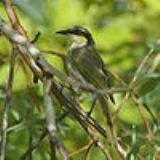
Singing Honeyeater
Encyclopedia
The Singing Honeyeater, Lichenostomus virescens is a small bird found in Australia
, and is part of the honeyeater
family. Although it is common there, it is not very well known in other places.
Singing Honeyeaters are commonly found in Western Australia, mainly past the Great Dividing Range
and on Western Australian Coastal Islands. They can also be spotted in city parks, gardens and in bushland
s.
The Singing Honeyeater can vary in length from 18–22 cm long. It has a brown color, but it also has other, more distinctive, colors. The tail and wings have a yellow-green color. There is a small black stripe spanning from the behind the bird’s beak to the bird’s back. Under the line there is a small bright yellow spot. The bird’s song ranges from scratchy to melodious. The song also varies according to where they live.
Singing Honeyeaters will eat a variety of foods. This includes nectar, small insects, fruits, grubs, and berries. This makes them omnivorous creatures.
The Singing Honeyeaters breed between July and February. They are capable of forming long time relationships with partners. When they are breeding, they show aggressive actions. Also they don’t have any particular color for their eggs, they all are different colors. Their nest is a cup of grass, plant stems, and spider webs.
The Singing Honeyeater lives in families. They will attack larger animals, if they feel threatened by them, or if they are in their territory. They have been known to attack intruders in mobs thus showing they are a community-like bird.
They associate with other species of birds, such as the Brown Honeyeater
and the Red Wattlebird
. It is different from many birds however, because it lacks the ability to communicate with other birds of the same species. As a study by M.C. Baker (1996) showed, the birds of the mainland did not respond to the songs of singing honey eaters found on an island off Australia’s west coast. The study showed that the songs of the birds on the island were smaller, had less song types, syllable types, and fewer syllables and notes per song.
Australia
Australia , officially the Commonwealth of Australia, is a country in the Southern Hemisphere comprising the mainland of the Australian continent, the island of Tasmania, and numerous smaller islands in the Indian and Pacific Oceans. It is the world's sixth-largest country by total area...
, and is part of the honeyeater
Honeyeater
The honeyeaters are a large and diverse family of small to medium sized birds most common in Australia and New Guinea, but also found in New Zealand, the Pacific islands as far east as Samoa and Tonga, and the islands to the north and west of New Guinea known as Wallacea...
family. Although it is common there, it is not very well known in other places.
Singing Honeyeaters are commonly found in Western Australia, mainly past the Great Dividing Range
Great Dividing Range
The Great Dividing Range, or the Eastern Highlands, is Australia's most substantial mountain range and the third longest in the world. The range stretches more than 3,500 km from Dauan Island off the northeastern tip of Queensland, running the entire length of the eastern coastline through...
and on Western Australian Coastal Islands. They can also be spotted in city parks, gardens and in bushland
Bushland
Bushland is any area in Australia that is predominantly indigenous flora and fauna.Bushland is the term commonly used by conservation protection groups and other environmental groups as a blanket term for natural vegetation, which may cover any kind of habitat from open shrubby country with few...
s.
The Singing Honeyeater can vary in length from 18–22 cm long. It has a brown color, but it also has other, more distinctive, colors. The tail and wings have a yellow-green color. There is a small black stripe spanning from the behind the bird’s beak to the bird’s back. Under the line there is a small bright yellow spot. The bird’s song ranges from scratchy to melodious. The song also varies according to where they live.
Singing Honeyeaters will eat a variety of foods. This includes nectar, small insects, fruits, grubs, and berries. This makes them omnivorous creatures.
The Singing Honeyeaters breed between July and February. They are capable of forming long time relationships with partners. When they are breeding, they show aggressive actions. Also they don’t have any particular color for their eggs, they all are different colors. Their nest is a cup of grass, plant stems, and spider webs.
The Singing Honeyeater lives in families. They will attack larger animals, if they feel threatened by them, or if they are in their territory. They have been known to attack intruders in mobs thus showing they are a community-like bird.
They associate with other species of birds, such as the Brown Honeyeater
Brown Honeyeater
The Brown Honeyeater is a honeyeater, a group of birds found mainly in Australia and New Guinea which have highly developed brush-tipped tongues adapted for nectar feeding...
and the Red Wattlebird
Red Wattlebird
The Red Wattlebird , also known as Barkingbird or Gillbird, is a honeyeater; a group of birds found mainly in Australia and New Guinea which have highly developed brush-tipped tongues adapted for nectar feeding...
. It is different from many birds however, because it lacks the ability to communicate with other birds of the same species. As a study by M.C. Baker (1996) showed, the birds of the mainland did not respond to the songs of singing honey eaters found on an island off Australia’s west coast. The study showed that the songs of the birds on the island were smaller, had less song types, syllable types, and fewer syllables and notes per song.
External links
- BirdLife Species Factsheet
- Singing Honeyeater. Birds of Perth
- "Singing Honeyeater." birdphotos . 15 Dec 2006 http://www.birdphotos.com.au/singinghoneyeaterweb/

